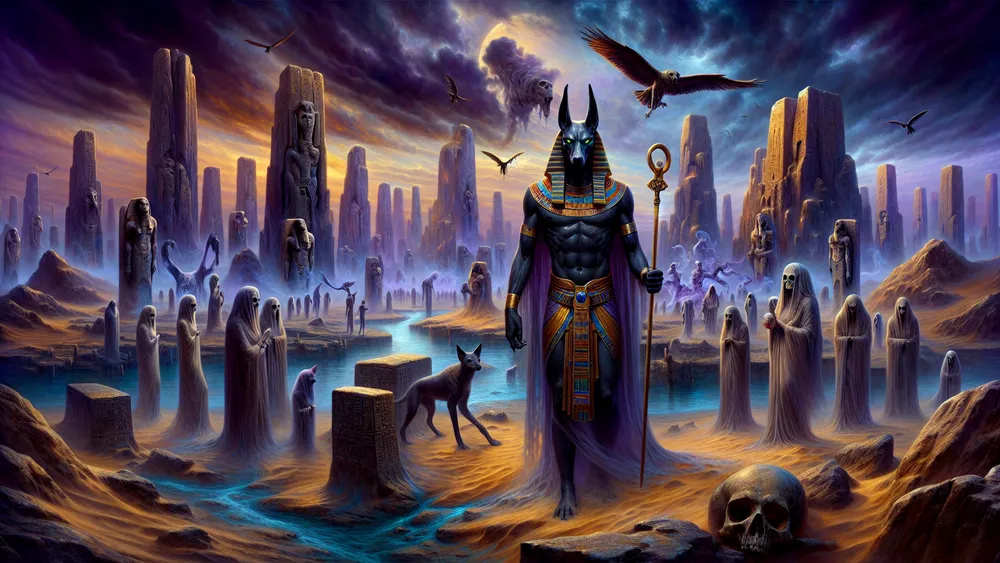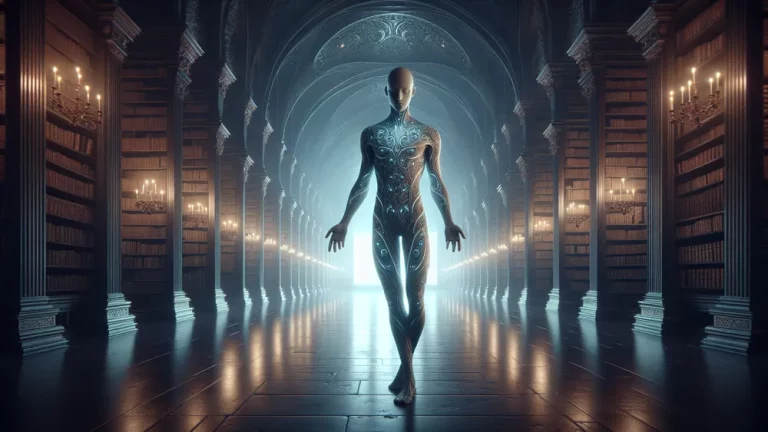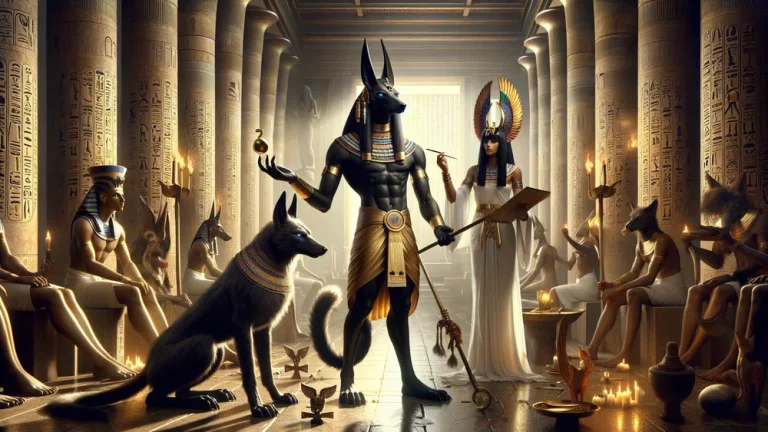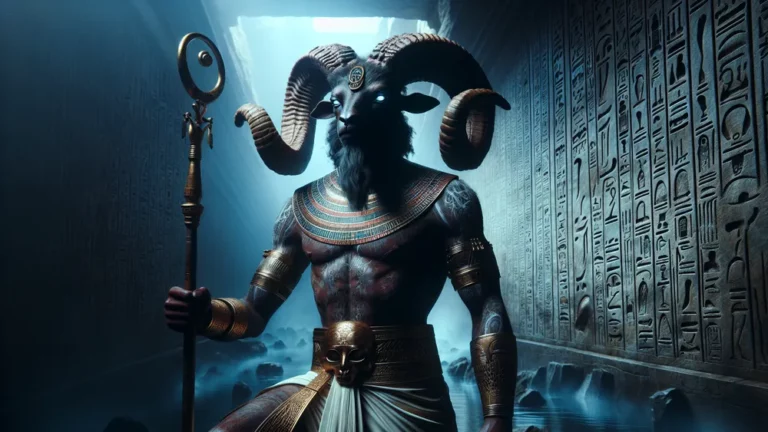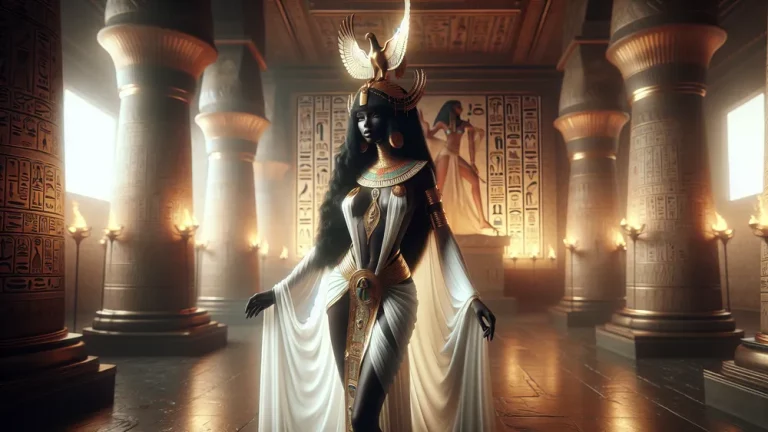Ancient Egyptian Duat: Mythical Underworld Realm
Think about starting a trip through a strange and complicated place, this spot where the living can’t go but the dead have to find their way through, it’s the Duat. The Duat belongs to old Egyptian myths and religious thinking. It’s not just where people go after they die; it’s a very complex and detailed place with many challenges, powerful beings, and deep meanings.
Key Points:
- The Duat is the ancient Egyptian underworld where souls go after death.
- It is a complex maze with different challenges, watched over by gods and monsters.
- The Duat is a key part of Egyptian beliefs, serving as the pathway to the afterlife.
- Important gods connected to the Duat include Osiris, Anubis, and Thoth.
- Souls face a 12-part trip through the Duat, culminating in a final judgment.
- The final judgment involves the weighing of the heart ceremony by Osiris and 42 judges.
- The Duat has influenced Egyptian art, stories, and modern culture, appearing in books, movies, and games.
In the paragraphs here, you will look into what Duat stands for, reading about its main parts, its place in Egyptian beliefs about the universe, and the tough trip souls have to go through to finally get judged.
By knowing about the Duat, you learn more about how old Egyptians saw life, death, and what happens after death, which shows a culture that is rich in spiritual thinking and full of myth as well.
Duat: Overview and Key Facts
| Main Point | Explanation |
|---|---|
| What it is | The Duat is the old Egyptian place for dead people, a place where souls go after they die. |
| Why it matters | Very important in Egyptian stories and religion, the Duat stands for the afterlife and what happens to the soul. |
| Main Traits | The Duat looks like a complicated maze with many areas, each with different problems and watched over by gods and monsters. |
| Role in the Universe | The Duat fits into the bigger picture of Egyptian beliefs as the middle space between the Earth and the sky, holding a key part in the cycle of being born, dying, and coming back. |
| Gods Connected with it | Important gods tied to the Duat include Osiris, Anubis, and Thoth, each having specific jobs in the trip and judging of the souls. |
| Soul’s Trip | The journey through the Duat means going through twelve parts, each with its tests, ending in the last judgment by Osiris and the 42 gods who decide. |
| Impact on Culture | The Duat idea has shaped Egyptian art, stories, and even modern culture, showing up in many kinds of media and fun stuff. |
Getting to Know the Duat
To really understand the Duat, one must look into its main parts and see how it joins the bigger picture of old Egyptian beliefs.
What’s the Duat All About?
In old Egyptian stories, the Duat is the place under the ground where souls go after they die. It can be seen as a magical maze the dead must go through to get to their final place. The Duat is very important in Egyptian religion because it shows the place where the soul faces tests and changes. The main things about the Duat are its big, complicated maze-like paths, different areas, each watched over by gods and creatures. To make things clearer, below are some main points about the Duat:

- Maze-like Paths: The Duat is shown as a huge, detailed maze.
- Gods and Creatures: Different gods and scary beings live in the Duat, each giving the souls problems.
- Deep Meaning: The Duat has a lot of symbolic meaning, showing the soul’s trip and the tests it must pass.
- End Judgment: The main aim of going through the Duat is to get to the final judgment, where the soul’s end is decided.
The Duat in old Egyptian stories is a symbolic maze-like place underground where souls face tests and judgment after death.
How the Duat Fits into Egyptian Beliefs
In the big picture of old Egyptian ideas, the Duat serves as the important in-between place between the Earth and the sky. Think of the Egyptian view of everything as a layered drawing, with the Earth where the living stay, the sky above where the gods live, and the Duat below as the place for the dead. This circular idea of life, death, and coming back is central to their beliefs, with the Duat working as the pathway for souls moving from living on Earth to the afterlife. Important gods have key parts in this process, leading and judging the souls. Here are some of the main gods linked with the Duat and what they do:
- Osiris: The god of the afterlife and the final decider of souls.
- Anubis: The god of wrapping bodies and the protector of graves, who leads souls through the Duat.
- Thoth: The god of wisdom and writing, who writes down the results of the final judgment.
- Ma’at: The goddess of truth and right, whose feather is used in the weighing of the heart ceremony.
The Duat Journey
Given that we have a basic idea of the Duat and its place in Egyptian thoughts, we should look at the trip that souls take through this magical place.
The Amduat: Roadmap to the Afterlife
The Amduat, which means “That Which Is in the Afterworld,” is an old Egyptian text for funerals that acts as a detailed guide for the dead, particularly for pharaohs, helping them navigate the dangerous trip through the Duat. Think of it as an old map or a guidebook, carefully showing the path the soul must take to get to the afterlife.

The main goal of the Amduat is to give the dead the knowledge and spells they need to get past the many obstacles they will meet in the underworld. This text was often written on the walls of royal tombs, so the pharaohs had access to this important information in their journey after death.
Pharaohs heavily relied on the Amduat to make it through the twelve-hour trip through the Duat, which is split into twelve different stages, each standing for an hour of the night. Each stage has its own challenges and guardians that the soul must face and get past. Here are some of the key stages and challenges shown in the Amduat:
- First Hour: The journey starts with the sun god Ra going into the western horizon, marking the beginning of the night.
- Fourth Hour: The soul meets a lake of fire, which must be crossed carefully.
- Sixth Hour: The most important point where the sun god fights the snake Apophis, showing chaos.
- Twelfth Hour: The last stage where the sun god is born again, coming out from the eastern horizon, marking the dawn and the soul’s successful trip to the afterlife.
Exploring the Twelve Sections of the Duat
The Duat is split into twelve unique sections, each one showing an hour of the night and a part of the soul’s trip through the underworld. Think of these sections like levels in a game, with each having its own challenges and guardians that the soul must beat to move forward to the next part.
These parts go in order, starting from the western edge where the sun sets and ending at the eastern edge where the sun rises, showing the soul’s rebirth and passage to the afterlife. Each section is carefully described in old texts, giving a clear map for the dead to follow.
Each of the twelve parts has its own meaning and shows special challenges the soul must face. For instance, the first part marks the beginning of the Duat and the start of the trip, while the sixth part is important since it involves a fight with the snake Apophis, a sign of chaos. The final, twelfth part means the soul’s rebirth as it comes out with the rising sun. To provide a better view, here is a summary of the main features of each section:

| Section | Key Features and Challenges |
|---|---|
| First | Entry into the Duat, beginning of the trip |
| Second | Meeting with different gods and guardians |
| Third | Going through a river of fire |
| Fourth | Moving along a dark, difficult path |
| Fifth | Facing hostile spirits |
| Sixth | Fight with the snake Apophis |
| Seventh | Moving through a field of knives |
| Eighth | Meeting with judgmental gods |
| Ninth | Going through a tricky maze |
| Tenth | Facing the gate guardians |
| Eleventh | Going through a lake of fire |
| Twelfth | Rebirth and coming out with the rising sun |
The Big Judgment Day
In the Duat, the last judgment is a key time when the soul’s future is decided. Much like a courtroom trial, the dead stand before Osiris, the afterlife god, and the 42 divine judges. Each judge stands for a different part of truth and morality, making sure the soul is judged correctly.
The main part of this judgment is the weighing of the heart ceremony, where the heart of the dead is weighed against the feather of Ma’at, the goddess of truth and justice. If the heart is lighter than the feather, the soul is seen as pure and allowed to go to the afterlife.
But, if the heart is heavier, it is eaten by Ammit, a scary creature, ending the soul’s existence.
The weighing of the heart ceremony has several important steps, each one meant to check the soul’s purity and if it followed Ma’at’s rules. Here are the main steps involved:
- Presentation: The dead shows their heart to Osiris and the 42 judges.
- Invocation: Prayers and spells are said to call Ma’at.
- Weighing: The heart is put on one side of a scale, with Ma’at’s feather on the other.
- Judgment: The judges look at the scale balance.
- Outcome: If the heart is lighter, the soul gets eternal life; if heavier, it is eaten by Ammit.
Who Lives in the Duat
First having explored the journey through the Duat, but also the final judgment, we now turn our focus to the beings who inhabit this mystical place.
Gods and Goddesses Hanging Out in the Duat
In the Duat, several important gods live who have crucial jobs in helping and judging the souls of those who have died. The main gods and goddesses related to the Duat are Osiris, Anubis, Ma’at, and Thoth. Osiris, the god of the afterlife, is in charge of the final judgment and makes sure each soul is judged fairly.
Anubis, the jackal-headed god, protects graves and guides souls, often shown supervising the heart weighing ceremony. Ma’at, the goddess of truth and justice, provides the feather for the weighing of the heart, representing moral order. Thoth, the ibis-headed god of wisdom and writing, writes down the results of the judgment.

These deities interact with the souls by leading them through the different parts of the Duat, making sure they face their tests and ultimately deciding their fate based on how they followed Ma’at’s rules.
Important gods in the Duat, such as Osiris, Anubis, Ma’at, and Thoth, play key roles in judging souls fairly based on their adherence to moral order.
Beasts and Baddies in the Duat
The gods and goddesses share the Duat with many scary monsters and demons that test dead souls. Ammit, the Devourer of the Dead, has the head of a crocodile, the body of a lion, and the back part of a hippo. Ammit eats the hearts of those found unworthy during the last judgment.
Another big creature is Apophis, a giant snake of chaos, trying to eat the sun god Ra during his night trip through the Duat. Also, there are many other demons and monster beings, such as snakes, crocodiles, and mixed creatures, each guarding various parts of the Duat and bringing different challenges to the souls moving through.
These creatures act as both challenges and tests for the souls walking through the Duat. For example, Apophis stands as the main test of beating chaos and darkness, a test the soul must pass to show its worth. Likewise, Ammit being present during the heart weighing ceremony brings another fear and speed, as the soul has to be pure to avoid being eaten.

While not like enemies in video games, these monsters and demons present certain challenges that a soul has to overcome to move to the next stage. Souls need to watch out for these dangers, rely on their moral honesty, and follow the gods to make it to the afterlife.
Here is a recap of some main creatures and what they do:
- Ammit: Eats unworthy hearts.
- Apophis: Snake of chaos, tries to eat Ra.
- Various Demons: Guard different parts, give unique challenges.
- Serpents and Crocodiles: Common blocks in the Duat.
Symbols and Cultural Influence
Since we have seen the beings of the Duat, we can look at how this magical place shows up in old Egyptian art and writings, and how it affects modern culture.
How the Duat Shows Up in Egyptian Art and Stories
The Duat appears in old Egyptian art and stories, working as a picture and story guide to the afterlife. Tomb paintings and papyrus scrolls often show scenes from the Duat, like the journey of the sun god Ra through twelve parts and the heart weighing event led by Osiris. Usual symbols and forms include the feather of Ma’at, standing for truth and justice, the scales used during judgment, and different pictures of gods, goddesses, and mythical creatures such as Ammit and Apophis.
These art pieces weren’t just for looks; they had deep cultural meaning, showing religious beliefs and moral values of old Egyptian people. Like today’s stories and movies show ideas through pictures, these old artworks worked as strong tools to talk about the secrets of the afterlife and the need to live a good life. Here are some main symbols and forms linked with the Duat:
- Feather of Ma’at: Stands for truth and justice.
- Scales of Judgment: Used during the heart weighing event.
- Pictures of Deities: Show the roles of gods and goddesses in the afterlife.
- Mythical Creatures: Show the challenges and tests in the Duat.
The Duat in Today’s Culture and Entertainment
The idea of the Duat has strongly influenced modern culture and media, showing up in different types of entertainment that grab the attention of people with its rich legends and unknown charms. Books like Rick Riordan’s “The Kane Chronicles” touch on Egyptian mythology, including the Duat, bringing old stories to current readers.
Movies, such as “The Mummy” series, and video games like “Assassin’s Creed Origins” include parts of the Duat, using themes of adventure and the afterlife to make their stories more interesting. Popular culture’s lasting interest in the Duat is due to its mysterious nature and people’s common curiosity about what happens after death. The Duat, like other mythical underworlds, mixes danger, mystery, and the promise of eternal life, making it an excellent setting for stories. Here are some well-known examples of the Duat in modern media:
- Books: “The Kane Chronicles” by Rick Riordan.
- Movies: “The Mummy” series.
- Video Games: “Assassin’s Creed Origins.”
FAQs
1. What is the Duat in ancient Egyptian mythology?
The Duat in ancient Egyptian mythology is the underworld realm where souls journey after death for judgment and potential rebirth.
2. How did ancient Egyptians get ready for their journey through the Duat?
To get ready for their journey through the Duat, ancient Egyptians performed elaborate burial rituals and recited specific spells from funerary texts like the Book of the Dead.
3. Who are the key deities tied to the Duat?
The key deities tied to the Duat include Osiris, Anubis, and Thoth, who play crucial roles in the afterlife journey and judgment process.
4. What hurdles did souls have to clear in the Duat?
The hurdles souls had to clear in the Duat included navigating through twelve perilous regions, facing monstrous creatures, and undergoing the final judgment by Osiris and the 42 divine judges.

